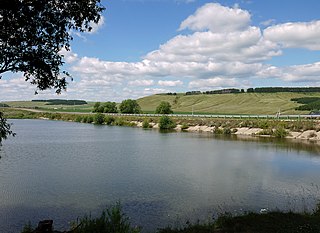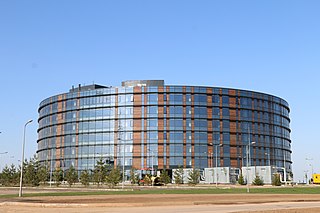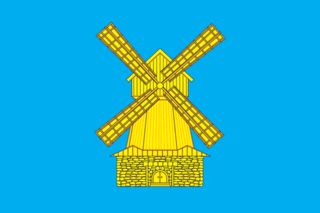
Zelenodolsk is a town in Tatarstan, Russia, located in the northwest of the republic on the left bank of the Volga River, 38 kilometers (24 mi) from Kazan. Population: 97,674 (2010 Census); 100,139 (2002 Census); 94,079 (1989 Soviet census).

Leninogorsk is a town in the Republic of Tatarstan, Russia, located 322 kilometers (200 mi) southeast of Kazan. Population: 64,127 (2010 Census); 65,592 (2002 Census); 62,093 (1989 Soviet census).

Nurlat is a town in the Republic of Tatarstan, Russia, located on the Kondurcha River, 268 kilometers (167 mi) southeast of Kazan. Population: 32,601 (2010 Census); 32,527 (2002 Census); 23,507 (1989 Soviet census).
Zainsk (Russian: Заи́нск is a town in the Republic of Tatarstan, Russia, located on the Stepnoy Zay River, 287 kilometers east of Kazan. Population: 39,739.

Bavly is a town in the Tatarstan, Russia, located on the Bavly River, 369 kilometers (229 mi) southeast of Kazan. Population: 22,109 (2010 Census); 22,939 (2002 Census); 20,025 (1989 Soviet census).
Buinsk is a town in the Republic of Tatarstan, Russia, located on the left bank of the Karla River, 137 kilometers (85 mi) southwest of Kazan. Population: 20,352 (2010 Census); 19,736 (2002 Census); 16,800 (1989 Soviet census).

Kamsko-Ustyinsky District is a territorial administrative unit and municipality of the Republic of Tatarstan within the Russian Federation. The district is located in the west of the republic, on the right bank of the Volga River. The territory of the district includes 49 settlements which are organized into three urban and seventeen rural settlements. The district population was 14,747 in 2020. The administrative center of the district is the urban-type settlement Kamskoye Ustye.

Kaybitsky District is a territorial administrative unit and municipality of the Republic of Tatarstan within the Russian Federation. The territory of the district includes 57 settlements and 17 rural settlements. Тhe district population was 13,415 at the beginning of 2020. The administrative center is the village of Bolshiye Kaybitsy.

Kukmorsky District is a territorial administrative unit and municipality of the Republic of Tatarstan within the Russian Federation. The district is located in the north of the republic and occupies a total area of 1,493 square kilometers (576 sq mi). According to the 2010 census, the municipality had a population of 52,021. As of 2020, the district population was 51,567 people. The administrative center of the district is the urban-type settlement of Kukmor which accounts for 32.5% of the district's total population.

Zainsky District is a territorial administrative unit and municipality of the Republic of Tatarstan in the Russian Federation. It is in the east of the republic. The administrative center is the city of Zainsk. The name comes from the ancient Tatar word "Зай" which means 'river'. As of the beginning of 2020, 53,698 people lived in the district. The urban population of the city is 39,631 while the rural population of the district is 14,067.
Alexeyevskoye is an urban locality and the administrative center of Alexeyevsky District in the Republic of Tatarstan, Russia, located on the Kama River on the left bank of the Kuybyshev Reservoir. As of the 2010 Census, its population was 11,224.
Kamskoye Ustye is an urban locality and the administrative center of Kamsko-Ustyinsky District in the Republic of Tatarstan, Russia, located on the Kuybyshev Reservoir, near the confluence of the Volga and Kama Rivers, 117 kilometers (73 mi) from the republic's capital of Kazan. As of the 2010 Census, its population was 4,482.

Innopolis is an urban settlement in Verkhneuslonsky District of the Republic of Tatarstan, Russia, a satellite of Kazan, the capital of the republic.
Aktyubinsky is an urban locality in Aznakayevsky District of the Republic of Tatarstan, Russia, located on the Leninogorsk–Aznakayevo auto route, 21 kilometers (13 mi) west of Aznakayevo. As of the 2010 Census, its population was 9,237.
Kuybyshevsky Zaton is an urban locality in Kamsko-Ustyinsky District of the Republic of Tatarstan, Russia, located on the shores of Kuybyshev Reservoir, 9 kilometers (5.6 mi) from Kamskoye Ustye, the administrative center of the district. As of the 2010 Census, its population was 2,677.

Kamskiye Polyany is an urban locality in Nizhnekamsky District of the Republic of Tatarstan, Russia, located on the left bank of the Kama River, 37 kilometers (23 mi) southwest of Nizhnekamsk, the administrative center of the district. As of the 2010 Census, its population was 15,795.

Dzhalil is an urban locality in Sarmanovsky District of the Republic of Tatarstan, Russia, located near the source of the Menzelya River, 35 kilometers (22 mi) south of Sarmanovo, the administrative center of the district. As of the 2010 Census, its population was 13,937.
Bolshaya Atnya is a rural locality and the administrative center of Atninsky District of the Republic of Tatarstan, Russia. Population: 3,536 (2010 Census); 3,651 (2002 Census);
Sarmanovo is a rural locality and the administrative center of Sarmanovsky District of the Republic of Tatarstan, Russia. Population: 7,153 (2010 Census); 6,327 (2002 Census); 5,374 (1989 Soviet census).
Tyulyachi is a rural locality and the administrative center of Tyulyachinsky District of the Republic of Tatarstan, Russia. Population: 3,265 (2010 Census); 2,943 (2002 Census);














